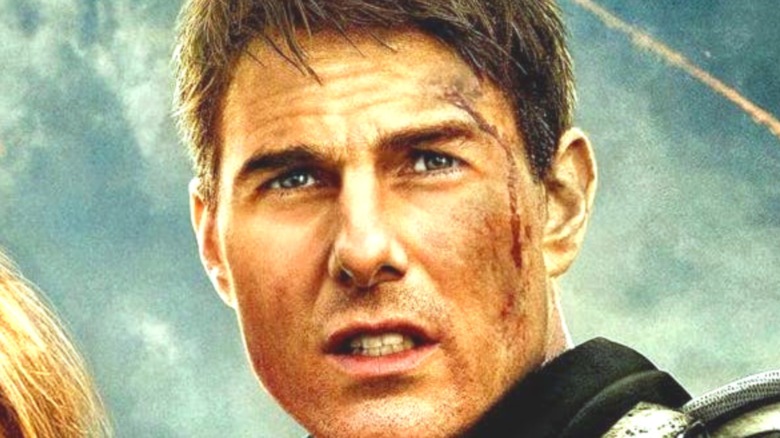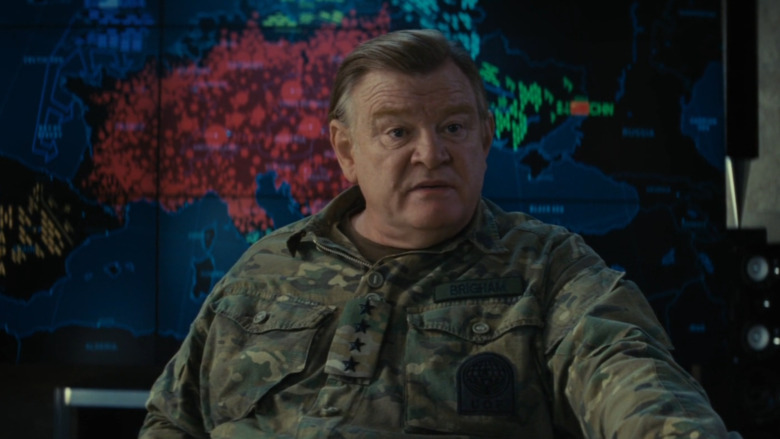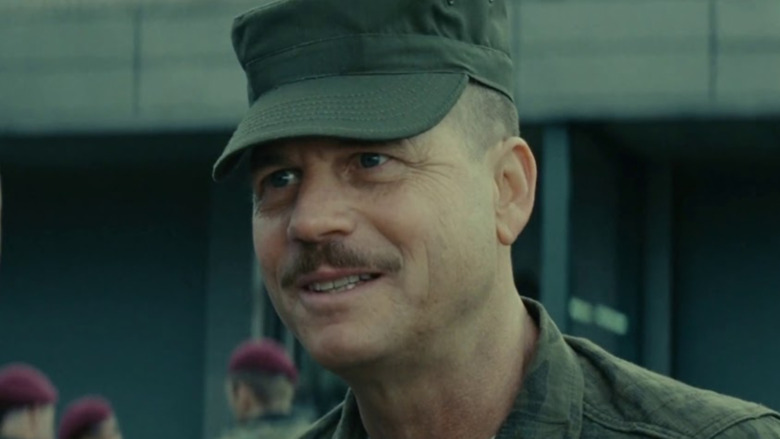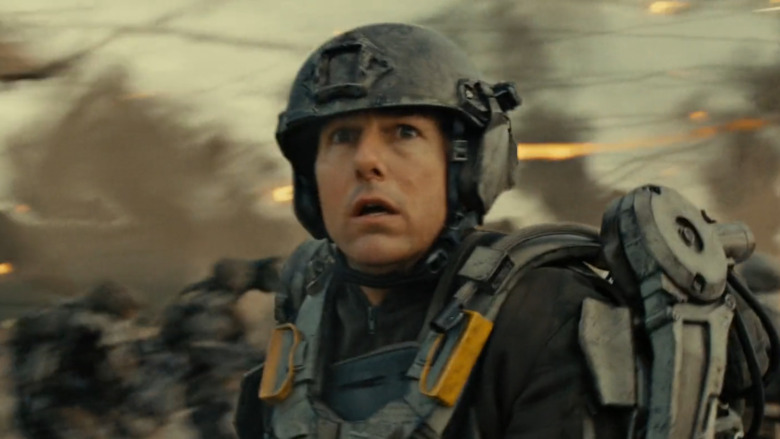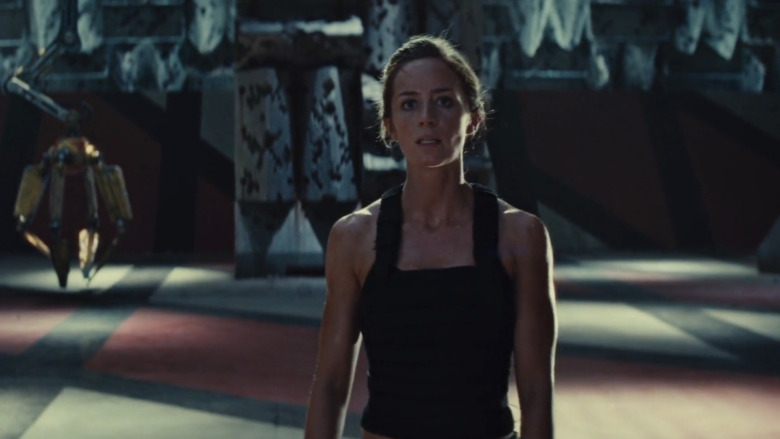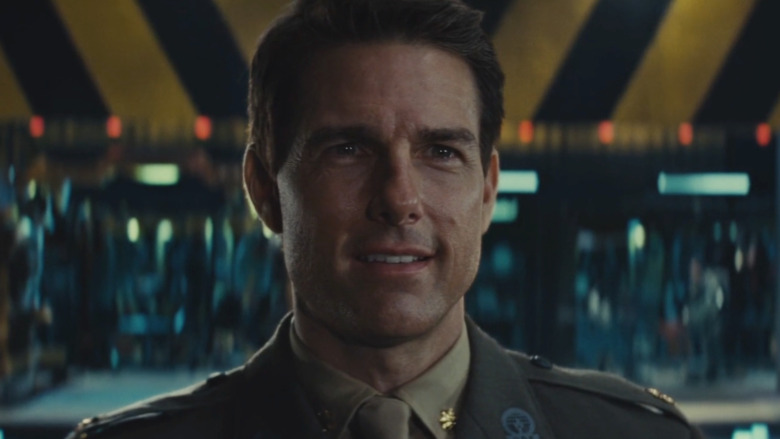Things You Only Notice About Edge Of Tomorrow After Watching It More Than Once
The time-looping sci-fi thriller "Edge of Tomorrow" gives viewers a lot to process, so it's a good thing events repeat themselves so often. Despite that fact, audiences may have missed some things after the first watch or, at the very least, failed to fully appreciate some aspects of the film. Starring Tom Cruise as Major William Cage and Emily Blunt as Sergeant Rita Vrataski, "Edge of Tomorrow" tells of a years-long alien invasion that starts in Europe. Mimics, a polymorphic, hive-mind swarm of aliens, are seemingly unstoppable and are gradually taking over the Earth. After a hard-fought victory in the French city of Verdun, courtesy of Sgt. Vrataski's epic combat performance with just a single day's training in the advanced combat armor used to fight the invasion, Maj. Cage leads a major media push for enlistment, touting the seeming ease with which Vrataski dispatched of the alien forces — again, with just one day of training. Of course, Cage soon learns that a single day of training can last a long time if it happens within a time loop.
This 2014 release arrived in the middle of a film-a-year stretch in Cruise's career, following another sci-fi flick in "Oblivion" and preceding his fifth installment of the "Mission: Impossible" franchise, "Rogue Nation." It enjoys a 91% critics score on Rotten Tomatoes and is Certified Fresh, with the critics consensus describing "Edge of Tomorrow" as "gripping, well-acted, funny, and clever." Audiences clearly loved the film as well, given that it grossed $370 million worldwide against a substantial $178 million budget (per Box Office Mojo). And yet, despite these pedigrees, certain aspects of the film will be lost on viewers who see it a single time.
Here are the things you only notice about "Edge of Tomorrow" after watching it more than once
General Brigham sends Cage exactly where the Omega is hiding
When General Brigham (Brendan Gleeson) talks with Major William Cage in the first act of "Edge of Tomorrow," he explains that the job of media relations is going to get a bit stickier. Brigham is sending him to the front to "sell the invasion"; Cage is going to ship out within the hour to join a camera crew and provide coverage of Operation Downfall, hitting the coast of France with the first wave of soldiers. "Satellites show minimal enemy movement on the coast," Brigham informs Cage, so they don't expect too much resistance. Brigham sells it as something exciting for Cage to tell his future grandchildren and, as he envisions it, it should be a cake walk.
There's just one problem with that idea: the Omega isn't in the middle of the Mimic horde — fortified behind the greatest number of drones — as we'd expect. While the enemy has overrun Europe, its central brain is near the very edge of the battle at the Louvre, in Paris, which is about a two-hour drive from the coast of France. While Brigham is trying to send Cage on a milk run to capture some good PR footage, he's unwittingly sending him right at the enemy's heart, figuratively.
Sgt. Farell describes Cage's arc within the first 12 minutes
Master Sergeant Farell (Bill Paxton) is a lot of things. Smart? Check. Funny? Check. Rocking one heck of a mustache? You bet your butt he is. But is he prophetic? Unwittingly, yes; nearly everything he spouts off to Major William Cage or the other troops comes true in "Edge of Tomorrow." When Sgt. Farell gives J Squad a verbal dressing down after finding them playing cards, he has them repeat a mantra — "Through readiness and discipline we are our masters of our fate" — and tells Cage that, though he might find that particular notion ironic, "Trust me; you'll come around." And come around he does, as we see throughout the film; through readiness and discipline, Cage becomes a master of his fate — everyone's fate, really. But that's not the only example.
After Cage wakes up at Forward Operating Base Heathrow, Sgt. Farell lays his cards out and tells the wayward major he knows Cage would do just about anything to avoid combat. "But that's not going to happen. Ever," Farell says, foreshadowing Cage's seemingly endless cycle of fighting and dying. As part of the same diatribe, he tells Cage that "Battle is the great redeemer. The fiery crucible in which the only true heroes are forged," which is exactly what happens during Cage's combat journey across his numerous deaths and rebirths. Battling his way through these countless series of fighting, killing, and dying, Cage is slowly shaped into the hero who is finally able to defeat the enemy at the film's climax.
Cage's visor doesn't break the second time he lands on the beach
Like a younger but less handsome Phil Connors (Bill Murray) in the darkest "Groundhog Day" timeline imaginable, Major William Cage is better prepared with every passing day in "Edge of Tomorrow." With each day — and each death — he has the opportunity to learn something new and get himself even further along the path to victory. After just his first death, Cage knows some critical information, though he's not yet reached the point of revealing which member of J Squad is actually there under his late friend's identity in order to support the family of the deceased — after all, he's not even 100% on how to disable the safety on his armor's weapons yet.
Cage is, however, armed with the knowledge that the troop transport is going to blow up en route to its assigned drop point. As such, he engages his drop line sooner than he did during his first foray into battle and is better prepared for the impact, the result of which is that the visor on his helmet — which broke the first time — remains intact. Ostensibly, Cage only suffers that particular equipment malfunction the one time across his many deaths, though he eventually ditches the helmet altogether — "It's a distraction."
The training robots are off when Cage and Vrataski meet in the end
At the end of "Edge of Tomorrow," Major William Cage meets the star of his recruitment campaign for about the millionth time, though it's Sergeant Rita Vrataski's first time meeting him. Their encounter takes place in the same place it did countless other times: on the training course at FOB Heathrow. But there's something different this time; it's a lot quieter and there aren't quite as many sources of imminent death nearby. That's right, the training robots aren't on.
While Vrataski is doing yoga like she usually is, the training equipment that we assume is meant to emulate a mimic's movement is not engaged, so there aren't any sharp objects racing around. The reason, of course, is simple: they believe they've pretty much won the war. If the enemy the soldiers signed up to fight is falling seemingly at their will, there's no need to train with equipment that mimics Mimics. Mind you, that doesn't stop Sergeant Farell from taking J Squad out for some good, ol' fashioned PT, but what are you gonna do?
Vrataski addresses Cage differently at the end
In addition to the lack of spinning wheels of death, there's another difference in the final scene, though perhaps it's less subtle: Rita Vrataski addresses Bill Cage differently. When they first meet in the training room — which is, of course, not actually the first time they met — she is not only impatient, she talks down to him. "Yes? Who said you could talk to me? Have I got something on my face, soldier?" The reason? Cage is wearing a private's uniform, having already met Master Sergeant Farell, so Vrataski believes she outranks him.
During "Edge of Tomorrow's" denouement, however, Cage is wearing his proper major's uniform, so the greeting Vrataski gives him doesn't quite have the same bite. "Yes? What do you want?" With the enlisted rank of sergeant, Vrataski seemingly knows better to mouth off to an officer, though she's still impatient — he does interrupt her yoga, after all; that peacock pose is no joke.
